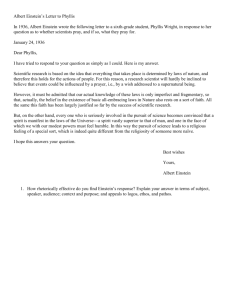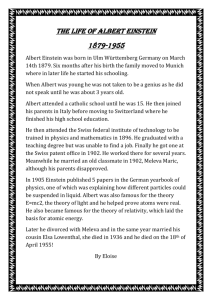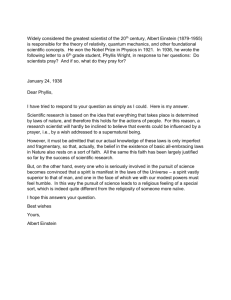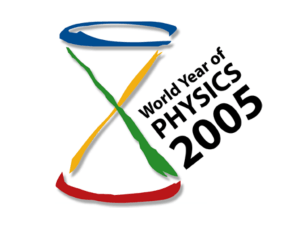Albert Einstein Chronology 1876 August 8 Hermann Einstein (b
advertisement
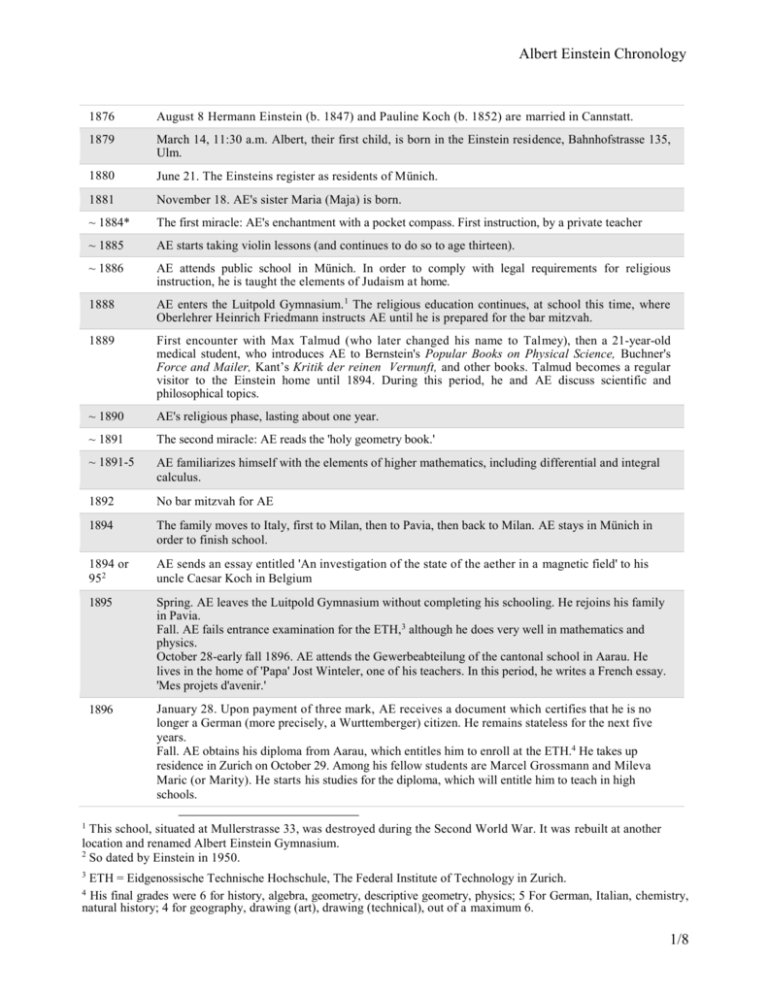
Albert Einstein Chronology
1876
August 8 Hermann Einstein (b. 1847) and Pauline Koch (b. 1852) are married in Cannstatt.
1879
March 14, 11:30 a.m. Albert, their first child, is born in the Einstein residence, Bahnhofstrasse 135,
Ulm.
1880
June 21. The Einsteins register as residents of Münich.
1881
November 18. AE's sister Maria (Maja) is born.
~ 1884*
The first miracle: AE's enchantment with a pocket compass. First instruction, by a private teacher
~ 1885
AE starts taking violin lessons (and continues to do so to age thirteen).
~ 1886
AE attends public school in Münich. In order to comply with legal requirements for religious
instruction, he is taught the elements of Judaism at home.
1888
AE enters the Luitpold Gymnasium. 1 The religious education continues, at school this time, where
Oberlehrer Heinrich Friedmann instructs AE until he is prepared for the bar mitzvah.
1889
First encounter with Max Talmud (who later changed his name to Talmey), then a 21-year-old
medical student, who introduces AE to Bernstein's Popular Books on Physical Science, Buchner's
Force and Mailer, Kant’s Kritik der reinen Vernunft, and other books. Talmud becomes a regular
visitor to the Einstein home until 1894. During this period, he and AE discuss scientific and
philosophical topics.
~ 1890
AE's religious phase, lasting about one year.
~ 1891
The second miracle: AE reads the 'holy geometry book.'
~ 1891-5
AE familiarizes himself with the elements of higher mathematics, including differential and integral
calculus.
1892
No bar mitzvah for AE
1894
The family moves to Italy, first to Milan, then to Pavia, then back to Milan. AE stays in Münich in
order to finish school.
1894 or
952
AE sends an essay entitled 'An investigation of the state of the aether in a magnetic field' to his
uncle Caesar Koch in Belgium
1895
Spring. AE leaves the Luitpold Gymnasium without completing his schooling. He rejoins his family
in Pavia.
Fall. AE fails entrance examination for the ETH,3 although he does very well in mathematics and
physics.
October 28-early fall 1896. AE attends the Gewerbeabteilung of the cantonal school in Aarau. He
lives in the home of 'Papa' Jost Winteler, one of his teachers. In this period, he writes a French essay.
'Mes projets d'avenir.'
1896
January 28. Upon payment of three mark, AE receives a document which certifies that he is no
longer a German (more precisely, a Wurttemberger) citizen. He remains stateless for the next five
years.
Fall. AE obtains his diploma from Aarau, which entitles him to enroll at the ETH.4 He takes up
residence in Zurich on October 29. Among his fellow students are Marcel Grossmann and Mileva
Maric (or Marity). He starts his studies for the diploma, which will entitle him to teach in high
schools.
1
This school, situated at Mullerstrasse 33, was destroyed during the Second World War. It was rebuilt at another
location and renamed Albert Einstein Gymnasium.
2
So dated by Einstein in 1950.
3
ETH = Eidgenossische Technische Hochschule, The Federal Institute of Technology in Zurich.
His final grades were 6 for history, algebra, geometry, descriptive geometry, physics; 5 For German, Italian, chemistry,
natural history; 4 for geography, drawing (art), drawing (technical), out of a maximum 6.
4
1/8
Albert Einstein Chronology
~ 1897
AE's meeting in Zurich with Michele Angelo Besso marks the beginning of a lifelong friendship
1899
October 19. AE makes formal application for Swiss citizenship.
1900
July 27. A board of examiners requests that the diploma be granted to, among others, the
candidates Grossmann and Einstein. The request is granted on July 28. AE's marks are 5 for
theoretical physics, experimental physics, astronomy; 5.5 for theory of functions; 4.5 for a diploma
paper (out of a maximum 6).
Fall. AE is unsuccessful in his efforts to obtain a position as assistant at the ETH.
December 13. From Zurich, AE sends his first paper to the Annalen der Physik.
1901
February 21. AE becomes a Swiss citizen. On March 13 he is declared unfit
for Swiss military service because of flat feet and varicose veins.
March-April. Seeking employment, AE applies without success to Ostwald in Leipzig and to
Kamerlingh Onnes in Leiden.
May 17. AE gives notice of departure from Zurich.
May 19-July 15. Temporary teaching position in mathematics at the technical high school in
Winterthur, where AE stays until October 14.
October 20-January 1902. Temporary leaching position in Schaffhausen.
December 18. AE applies for a position at the patent office in Bern.
1902
February 21. E, arrives in Bern. At first his only means of support are a small allowance from the
family and fees from tutoring in mathematics and physics.
June 16. The Swiss federal council appoints AE on a trial basis as technical expert third class at the
patent office in Bern, at an annual salary of SF 3500. AE starts work there on June 23.
October 10. F..'s father dies in Milan
1903
January 6. AE marries Mileva Maric.
Conrad Habicht, Maurice Solovine, and AE found the 'Akademie Olympia.' December 5. AE
presents a paper, 'Theory of Electromagnetic Waves,' before the Naturforsehende Gesellschaft in
Bern.
1904
May 14. Birth of AE's first son, Hans Albert (d. 1973 in Berkeley, California).
September 16. The trial appointment at the patent office is changed to a permanent appointment
1905
March 17. AE completes the paper on the light-quantum hypothesis.
April 30. AE completes his PhD thesis, 'On a new determination of molecular dimensions ' The thesis,
printed in Bern and submitted to the University of Zürich, is accepted in July. It is dedicated to 'meinem
Freunde Herrn DrM. Grossmann.'
May 11. The paper on Brownian motion is received. 5 June 30. The first paper on special relativity is
received. 5
September 27. The second paper on special relativity theory is received.5 It contains the relation E =
me2.
December 19. A second paper on Brownian motion is received.5
1906
April 1. AE is promoted to technical expert second class. His salary is raised to SF 4500/annum.
November. AE completes a paper on the specific heats of solids, the first paper ever written on the
quantum theory of the solid state.
1907
'The happiest thought of my life': AE discovers the principle of equivalence for uniformly accelerated
mechanical systems. He extends the principle to electromagnetic phenomena, gives the correct
expression for the red shift, and notes that this extension also leads to a bending of light which passes a
massive body, but believes that this last effect is too small to be detectable.
June 17. AE applies for a position as Privatdozent at the University of Bern. The application is
rejected since it is not accompanied by the obligatory Habilitationsschrift
1908
February 28. Upon second application, AE is admitted at Bern as Privatdozent. His unpublished
Habilitationsschrift is entitled 'Consequences for the constitution of radiation following from the energy
distribution law of black bodies.'
Early in the year, J J. Laub becomes AE's first scientific collaborator. They publish two joint papers.
December 21. Maja receives the PhD degree in Romance languages magna cum laude from the
5
By the Annalen der Physik
2/8
Albert Einstein Chronology
University of Bern.
1909
March and October. AE completes two papers, each of which contains a conjecture on the theory of
blackbody radiation. In modern terms, these two conjectures are complementarity, and the
correspondence principle. The October paper is presented at a conference in Salzburg, the first
physics conference AE attended.
July 6. AE submits his resignation (effective October 15) to the patent office. He also resigns from
his Privaldozent position.
July 8. AE receives his first doctorate honoris causa, at the University of Geneva.6
October 15. AE starts work as associate professor at the University of Zürich with a beginning
salary of SF 4500/annum
1910
March. Maja marries Paul Winteler, son of Jost Winteler.
July 28. Birth of AE's second son, Eduard ('Tede' or Tedel,' d. 1965 in psychiatric hospital
Burghützli).
October. AE completes a paper on critical opalescence, his last major work in classical statistical
physics.
1911
Emperor Franz Joseph signs a decree appointing AE full professor at the Karl-Ferdinand University
in Prague, effective April 1
March. AE moves to Prague
June. AE recognizes that the bending of light should be experimentally detectable during a total solar
eclipse. He predicts an effect of 0".83 for the deflection of a light ray passing the sun (half the correct
answer).
October 30-November 3: the first Solvay Conference AE gives the concluding address, 'The Current
Status of the Problem of Specific Heats.'
1912
Early February. AE is appointed professor at the ETH.
August. AE moves back to Zürich.
1912-13
AE collaborates with Grossmann (now professor of mathematics at the ETH) on the foundations
of the general theory of relativity. Gravitation is described for the first time by the metric tensor. They
believe that they have shown that the equations of the gravitational field cannot be generally
covariant.
1913
Spring. Planck and Nernst visit AE in Zürich to sound him out about coming to Berlin. The offer
consists of a research position under the aegis of the Prussian Academy of Sciences, a professorship
without teaching obligations at the University of Berlin, and the directorship of the (yet to be
established) Kaiser Wilhelm Institute for Physics.
June 12. Planck, Nernst, Rubens, and Warburg formally propose AE for membership in the Prussian
Academy in Berlin.
July 3. This proposal is accepted by a vote of twenty-one to one (and approved by Emperor
Wilhelm II on November 12). December 7. AE accepts the position in Berlin.
1914
April 6. AE moves to Berlin with wife and children. Soon after, the Einsteins separate. Mileva and the
boys return to Zürich. Albert moves into a bachelor apartment at Wittelsbacherstrasse 13.
April 26. AE's first newspaper article appears, in Die Vossische Zeitung, a Berlin daily. It deals with
relativity theory.
July 2. AE gives his inaugural address at the Prussian Academy.
August 1. Outbreak of World War I
1915
Early in the year. AE holds a visiting appointment at the Physikalisch Technische Reichsanstalt
in Berlin, where he and de Haas perform gyromagnetic experiments.
AE cosigns a 'Manifesto to Europeans' in which all those who cherish the culture of Europe are urged to
join in a League of Europeans, probably the first political document to which he lends his name.
Late June-early July. AE gives six lectures in Goettingen on general relativity theory. 'To my great joy,
I completely succeeded in convincing Hilbert and [Felix] Klein.'
November 4. AE returns to the requirement of general covariance in general relativity, constrained,
6
In later years, Einstein also received honorary degrees from Zurich, Rostock, Madrid, Brussels,
Buenos Aires, the Sorbonne, London, Oxford, Cambridge, Glasgow, Leeds. Manchester, Harvard,
Princeton, New York Stale at Albany, and Yeshiva. This list is most probably incomplete
3/8
Albert Einstein Chronology
however, by the condition that only unimodular transformations are allowed.
November 11. AE replaces the unimodular constraint by the even stronger one that (—detg,)1/2 = 1.
November 18. The first post-Newtonian results. AE obtains 43" per century for the precession of the
perihelion of Mercury. He also finds that the bending of light is twice as large as he thought it was in
1911.
November 20. David Hilbert submits a paper to the Goettingen Gesell-schaft der Wissenschaften
containing the final form of the gravitational field equations (along with an unnecessary' assumption on
the structure of the energy-momentum tensor).
November 25. Completion of the logical structure of general relativity. AE finds that he can and should
dispense with the constraints introduced on November 4 and 11.
1916
March 20. 'Die Grundlage der allgemeinen Relativitatstheorie,' the first systematic expose of general
relativity is received by the Annaten der Physik and later, in 1916, published as AE's first book.
May 5. AE succeeds Planck as president of the Deutsche Physikalische Gesellschaft.
June. AE's first paper on gravitational waves. He discovers that (in modern language) a graviton has
only two states of polarization.
July. AE returns to the quantum theory. During the next eight months, he publishes three
overlapping papers on the subject, containing the coefficients of spontaneous and induced emission and
absorption, a new derivation of Planck's law, and the first statement in print by AE that a light-quantum
with energy hv carries a momentum hv/c. First discomfort about 'chance in quantum physics
December. AE completes Uber die Spezielle and die Allgemeine Relativitatstheorie,
Gemeinverstandlich, his most widely known book. It is later translated into many languages.
December The emperor authorizes the appointment of AE to the board of governors of the
Physikalisch Technische Reichsanstalt. AE holds this position from 1917 until 1933.
1917
February. AE writes his first paper on cosmology and introduces the cosmological term.
AE suffers successively from a liver ailment, a stomach ulcer, jaundice, and general weakness. His
cousin Elsa takes care of him. He does not fully recover until 1920.
October 1. The Kaiser Wilhelm Institute begins its activities (both experimental and theoretical) under
AE's directorship.
1918
February. AE's second paper on gravitational waves. It contains the quadrupole formula.
November. AE declines a joint offer from the University of Zurich and the ETH.
1919
January-June. E- spends most of this period in Zürich, where he gives a series of lectures at the
university.
February 14. AE and Mileva are divorced.
May 29. A total solar eclipse affords opportunities for measuring the bending of light. This is done
under Eddington on the island of Principe and under Crommelin in northern Brazil.
June 2. AE marries his divorced cousin Elsa Einstein Lowenthal 7 (b. 1874). Her two daughters, Use
(b. 1897) and Margot (b. 1899), had earlier taken the name Einstein by legal decree. The family moves
into an apartment on Haberlandstrasse 5.
September 22. AE receives a telegram from Lorentz informing him that preliminary analysis of the May
eclipse data indicates that the bending of light lies between the 'Newton' value (0".86) and the
'Einstein' value (1".73).
November 6. At a joint meeting of the Royal Society and the Royal Astronomical Society in London, it
is announced that the May observations confirm Einstein's predictions.
November 7. Headlines in the London Times; 'Revolution in science/ New theory of the Universe /
Newtonian ideas overthrown'.
November 10. Headlines in The New York Times: 'Lights all askew in the heavens / Einstein theory
triumphs.' Press announcements such as these mark the beginning of the perception by the general
public of Einstein as a world figure.
December. Einstein receives his only German honorary degree: doctor of medicine at the University of
Rostock.
Discussions about Zionism with Kurt Blumenfeld.
1920
February 12. Disturbances occur during a lecture given by AE at the University of Berlin. AE states
in the press that expressions of anti-Semitism as such did not occur although the disturbances could be
so interpreted.
March. AE's mother dies in AE's home.
7
Elsa's father was Rudolf AE, a cousin of AE's father, Hermann. Her mother was nee Fanny Koch,
a sister of AE's mother, Pauline, so that Elsa was a cousin of AE from both his parents' sides.
4/8
Albert Einstein Chronology
June. AE lectures in Norway and Denmark.
AE and Bohr meet for the first time, in Berlin.
August 24. Mass meeting against general relativity theory in Berlin. AE attends the meeting.
August 27. AE publishes a bitter retort in the Berliner Tageblatt. German newspapers report that AE
plans to leave Germany. Laue, Nernst, and Rubens, as well as the minister of culture Konrad Haenisch,
express their solidarity with AE in statements to the press.
September 8. In a letter to Haenisch, AE states that Berlin is the place with which he feels most
closely connected by human and scientific relations. He adds that he would only respond to a call from
abroad if external circumstances forced him to do so.
September 23. Confrontation with Philipp Lenard at the Bad Nauheim meeting.
October 27. AE gives an inaugural address in Leiden as a special visiting professor. This position will
bring him there a few weeks per year. 8
From 1920 on, AE begins to publish nonscientific articles.
December 31. AE is elected to the Ordre pour le Merite
1921
April 2-May 30. First visit to the United States, with Chaim Weizmann, for the purpose of raising
funds for the planned Hebrew University in Jerusalem. At Columbia University, AE receives the
Barnard medal. He is received al the White House by President Harding. Visits to Chicago, Boston, and
Princeton, where he gives four lectures on relativity theory.
On his return trip, AE stops in London, where he visits Newton's tomb.
1922
January. AE completes his first paper on unified field theory.
March-April. AE's visit to Paris contributes to the normalization of Franco-German relations.
AE accepts an invitation to membership of the League of Nations' Committee on Intellectual
Cooperation (CIC), four years before Germany's admission to the League.
June 24. Assassination of Walther Rathenau, German Foreign Minister, an acquaintance of AE's.
October 8. AE and Elsa board the S.S. Kitano Maru in Marseille, bound for Japan. On the way, they
visit Colombo, Singapore, Hong Kong, and Shanghai.
November 9. The Nobel prize for physics for 1921 is awarded to AE while he is en route to Japan.
November 17-December 29, AE visits Japan.
December 10. At the Nobel prize festivities AE is represented by the German envoy, Rudolf Nadolny 9
His citation reads, 'To A. AE for his services to theoretical physics and especially for his discovery of
the law of the photoelectric effect.'
1923
February 2. On his way back from Japan, AE arrives in Palestine for a twelve-day visit. On
February 8 he is named the first honorary citizen of Tel Aviv. On his way from Palestine to
Germany, he visits Spain.
March. Disillusioned with the effectiveness but not with the purposes of the League of Nations, AE
resigns from the CIC.
June-July. AE helps found the Association of Friends of the New Russia and becomes a member of its
executive committee10
July. AE gives a lecture on relativity in Goteborg in acknowledgment of his Nobel prize
The discovery of the Compton effect ends the long-standing resistance to the photon concept.
December. For the first time in a scientific article, AE presents his conjecture that quantum effects may
arise from overconstrained general relativistic field equations.
1924
As an act of solidarity, AE joins the Berlin Jewish community as a dues-paying member.
AE edits the first collection of scientific papers of the Physics Department of the Hebrew University.
The 'Einstein-Institute' in Potsdam, housed in the 'Einstein-Tower,' starts its activities. Its main
instrument is the 'Einstein-Telescope'
Ilse AE marries Rudolf Kayser.
June. AE reconsiders and rejoins the CIC.
June 7. AE states that he does not object to the opinion of the German Ministry of Culture that his
appointment to the Prussian Academy implies that he has acquired Prussian citizenship. (He retains his
Swiss citizenship.)
December. AE's last major discovery: from the analysis of statistical fluctuations he arrives at an
independent argument for the association of waves with matter. Bose-Einstein condensation is also
discovered by him at that time.
8
Einstein again visited Leiden in November 1921, May 1922, May 1923, October 1924, February 1925, and
April 1930. His visiting professorship was officially terminated on September 23, 1952.
9
The prize was brought to AE's home by the Swedish Ambassador after AE returned from Japan.
10
AE never visited the Soviet Union. The association was disbanded in 1953.
5/8
Albert Einstein Chronology
1925
May-June. Journey to South America. Visits to Buenos Aires, Rio de Janeiro, and Montevideo.
AE signs (with Gandhi and others) a manifesto against obligatory military service.
AE receives the Copley medal.
AE serves on the Board of Governors of the Hebrew University (until June 1928).
1926
AE receives the gold medal of the Royal Astronomical Society
1927
May 7. Hans Albert AE marries Frida Knecht in Dortmund.
October. The fifth Solvay Conference. Beginning of the dialogue between AE and Bohr on the
foundations of quantum mechanics.
1928
February or March. AE suffers a temporary physical collapse brought about by physical overexertion.
An enlargement of the heart is diagnosed. He has to stay in bed for four months and must keep a saltfree diet. He fully recuperates but remains weak for almost a year.
Friday, the thirteenth of April. Helen Dukas starts to work for AE.
1929
First visit with the Belgian royal family. Friendship with Queen Elizabeth, with whom he corresponds
until the end of his life.
June 28. Planck receives the first, AE the second Planck medal. On this occasion AE declares that he is
'ashamed' to receive such a high honor since all he has contributed to quantum physics are 'occasional
insights' which arose in the course of 'fruitless struggles with the main problem’.
1930
Birth of Bernhard Caesar ('Hardi'), son of Hans Albert and Frida Einstein, AE's first grandchild.11
May, AE signs the manifesto for world disarmament of the Women's International League for Peace
and Freedom.
November 29. Margot Einstein marries Dimitri Marianoff. (This marriage ended in divorce)
December 11-March 4, 1931. AE's second stay in the United States, mainly at CalTech.
December 13. Mayor Jimmy Walker presents the key to the city of New York to AE
December 19-20. AE visits Cuba.
1931
April. AE rejects the cosmological term as unnecessary and unjustified.
December 30-March 4, 1932. AE's third stay in the United States, again mainly at CalTech.
1932
February. From Pasadena AE protests against the conviction for treason of the German pacifist Carl
von Ossielzky.
April. AE resigns for good from the CIC.
October. AE is appointed to a professorship at The Institute for Advanced Study in Princeton, New
Jersey. The original intent is that he divides his time about evenly between Princeton and Berlin.
December 10. AE and his wife depart from Germany for the United States. This stay was again
planned to be a visit. However, they never set foot in Germany again.
1933
January 30. The Nazis come to power.
March 20. In his absence, Nazis raid AE's summer home in Caputh to look for weapons allegedly
hidden there by the Communist party.
March 28. On his return to Europe, AE sends his resignation to the Prussian Academy. He and his
wife settle temporarily in the villa Savoyarde in Le Coq sur Mer, on the Belgian coast, where two
Belgian security guards are assigned to them for protection. They are joined by Ilse, Margot, Helen
Dukas, and Walther Mayer, AE's assistant. During the next few months, AE makes brief trips to
England and also to Switzerland, where he sees his son Eduard for the last time Rudolf Kayser sees to
it that AE's papers in Berlin are saved and are sent to the Quai d'Orsay by French diplomatic pouch
April 21. AE resigns from the Bavarian Academy of Sciences.
An exchange of letters between AE and Freud is published as a slim volume entitled Why War?
June 10. AE gives the Herbert Spencer lecture in Oxford.
September 9. AE leaves the European continent for good and goes to England.
October 17. Carrying visitor’s visas, AE, his wife, Helen Dukas, and Mayer arrive in the United
States and proceed to Princeton that same day. A few days later the first three move to 2 Library
Place.
Ilse and Margot stay in EuropAE
1934
Death of Ilse Kayser-Einstein in Paris. Soon thereafter, Margot and her husband join the family in
Princeton.
11
A second grandson died at age six. By adoption, AE also had a granddaughter named Evelyn
6/8
Albert Einstein Chronology
1935
May. AE makes a brief trip to Bermuda. From there he makes formal application for permanent
residency in the United States. It is the last time that he leaves the United States.
Autumn. The family and Helen Dukas move to 112 Mercer Street in Princeton.
AE receives the Franklin medal.
1936
September 7. Death of Marcel Grossmann.
December 20. Death of Elsa Einstein
Hans Albert Einstein receives a Ph.D in Technical Sciences from the ETH.
1939
Maja joins her brother at Mercer Street, which remains her home for the rest of her life.
August 2. AE sends a letter to F. D. Roosevelt in which he draws the latter's attention to the military
implications of atomic energy.
1940
October 1. In Trenton, Judge Phillip Forman inducts Margot, Helen
Dukas, and AE as citizens of the United States. AE also retains his Swiss
citizenship.
1943
May 31. AE signs a consultant's contract (eventually extended until June 30, 1946) with the Research
and Development Division of the U.S. Navy Bureau of Ordnance, section Ammunition and
Explosives, subsection 'High Explosives and Propellants.' His consultant's fee is $25 per day.
1944
A copy of AE's 1905 paper on special relativity, handwritten by him for this purpose, is auctioned for
six million dollars in Kansas City, as a contribution to the war effort (manuscript now in Library of
Congress).
1945
December 10. AE delivers an address in New York, 'The War is Won but Peace is Not.'
1946
Maja has a stroke and remains bedridden.
AE agrees to serve as chairman of the Emergency Committee for Atomic Scientists.
October. AE writes an open letter to the general assembly of the United Nations, urging the formation
of a world government.
1947
Hans Albert AE is appointed professor of engineering at the University of
California, Berkeley.
1948
August 4. Death of Mileva in Zürich.
December. An exploratory laparotomy on AE discloses a large intact aneurysm of the abdominal aorta
1949
January 13. AE leaves the hospital.
Publication of the 'necrology,' written by AE, a largely scientific review entitled Autobiographisches.
1950
March 18. AE signs and seals his last will and testament. Dr Otto Nathan is named as sole
executor. Dr Nathan and Helen Dukas are named jointly as trustees of his estate The Hebrew
University is named as the ultimate repository of his letters and manuscripts. Among other
stipulations, his violin is bequeathed to his grandson Bernhard Caesar.
1951
June. Death of Maja in Princeton
1952
July. Death of Paul Winteler at the home of his brother-in-law, Besso, in Geneva.
November. AE is offered and declines the presidency of Israel.
1954
April 14. The press carries a statement of support by AE for J. R. Oppenheimer on the occasion of
allegations brought against the latter by the U.S. Government.
Last meeting of AE and Bohr (in Princeton). AE develops hemolytic anaemia.
1955
March 15. Death of Besso.
April 11. AE's last signed letter (to Bertrand Russell), in which he agrees to sign a manifesto urging
all nations to renounce nuclear weapons. That same week, AE writes his final phrase, in an unfinished
manuscript: 'Political passions, aroused everywhere, demand their victims.'
April 13. Rupture of the aortic aneurysm.
April 15. AE enters Princeton Hospital.
April 16. Hans Albert AE arrives in Princeton from Berkeley.
April 17. AE telephones Helen Dukas: he wants writing material and the sheets with his most recent
calculations.
7/8
Albert Einstein Chronology
April 18, 1:15 a.m. AE dies. The body is cremated in Trenton at 4 p.m. that same day. The ashes are
scattered 12 at an undisclosed place.
November 21. Thomas Martin, son of Bernhard Caesar, son of Hans Albert, is born in Bern, the
first of the great-grandchildren of Albert Einstein.
12
By Olio Nathan and Paul Oppenheim.
8/8



